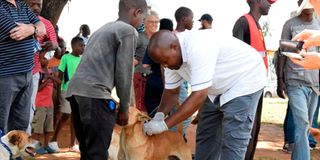To eradicate rabies, let’s deploy the necessary resources to fighting it

Dr Johannes Mwita vaccinates a dog against rabies in Mombasa on September 21, 2019.
An estimated 2,000 Kenyans die of rabies every year. Transmitted from a rabid dog to humans via a bite or a scratch — and less frequently from other animals — rabies has been dreaded for thousands of years.
Globally, the disease kills 59,000 people, mostly children in marginalised and poor regions of Africa and Asia. It also causes annual economic losses to the tune of 8.6 billion dollars.
“Rabies” has its origins in a Latin word meaning madness, rage and fury. Since the first dog and human rabies cases were confirmed in Kenya about a century ago, the country has grappled to control and eliminate the scourge. Between the 1950s and ’70s, huge strides were made through a government-mandated compulsory annual dog vaccination programme. These efforts resulted in a sharp decline in both types of rabies.
However, since the 1970s, rabies cases have ticked up, coinciding with the implementation of the Structural Adjustment Programmes (SAPs). These led to the privatisation of veterinary services and a subsequent collapse of the annual dog vaccination, making the disease endemic.
What makes this outcome especially tragic is that rabies is 100 per cent preventable through vaccines. Effective dog vaccination campaigns have been shown to be more affordable than human pre- and post-exposure vaccination. Through this strategy, Latin America and the Caribbean are on the cusp of eliminating human rabies deaths
In 2015, Kenya and other countries where the disease is prevalent set out to achieve zero human rabies deaths by 2030. The Kenya National Rabies Elimination Strategic Plan (2014-2030) was developed. It is anchored on four pillars: Mass dog vaccination targeting coverage of 70 per cent for three consecutive years; provision of pre- and post-exposure vaccination for animal bite victims; public education and awareness on rabies prevention and control; and enhanced surveillance for rabies cases in humans and animals.
This strategy is being implemented by the Zoonotic Disease Unit (ZDU) — a collaborative unit between the Ministry of Agriculture, Livestock, Fisheries and Cooperatives and that of Health. Its development was supported by the Global Alliance for Rabies Control (GARC) and a tripartite collaboration of WHO, OIE and FAO.
We are in Stage Three of the strategy, which entails rabies risk reduction through full-scale implementation of the control strategy. We have nine years remaining to the set timeline of elimination.
Unfortunately, the implementation process is plagued by challenges that can erode and or derail the gains made. Limited domestic funding, enough to carry out an effective dog vaccination campaign and related activities, poses the most significant challenge.
For example, the health budget at national and county government levels is 9.1 per cent of the total, far below the government commitment of 15 per cent, according to the Abuja Declaration (a pledge by African governments to allocate at least 15 per cent of their annual budgets to the health sector).
There is an urgent need for treasury departments at national and county levels to reevaluate budgets for disease control and especially rabies. And there is a need to catalyse domestic, regional and international funding options to raise funds for implementing sustainable disease control measures.
An essential first step would be revamping surveillance systems to ensure that the disease burden is correctly captured. Most human deaths from rabies are under-reported and often misclassified as “other diseases”, presenting with neurological signs such as meningitis and cerebral malaria.
It is possible that this underreporting drives a cycle of neglect for rabies. Further, in-county researchers should provide economic data to support increased budgetary allocation towards control drives. The news isn’t entirely grim: There is growing momentum to address these issues towards 2030.
Today is World Rabies Day, a global day of action dedicated to rabies awareness and prevention. Let’s harness and direct capital and human resources to the noble goal of attaining zero human rabies deaths by 2030.
Dr Maurice Karani is a joint PhD graduate fellow at the University of Liverpool (UK) and the One Health Centre in Africa led by the International Livestock Research Institute (Kenya).




